The
Educational Achievement of Indian Children
APPENDIX
United States Indian Bureau
Tests
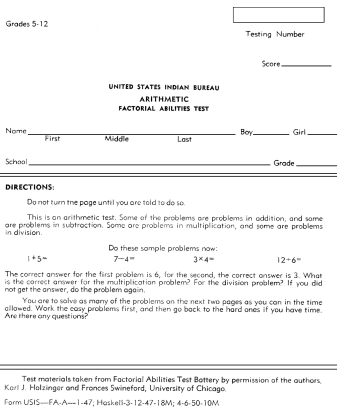
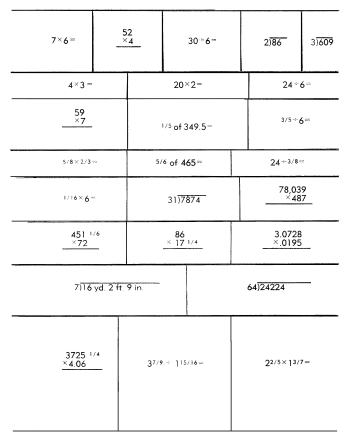
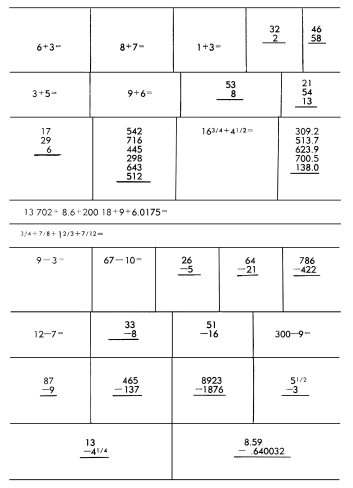
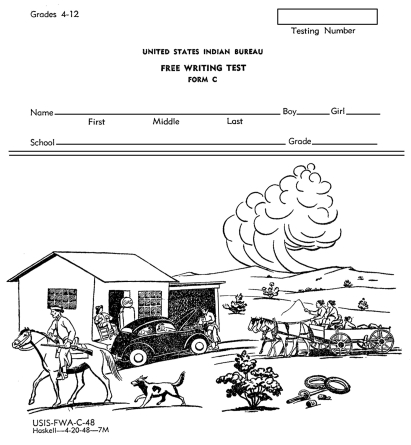
DIRECTIONS: Write one or more. paragraphs telling the story
which the picture on the front page suggests to you. In this
story, be sure that you include something about:
I . The man on horseback with his dog, telling what you think
he is going to do.
2. The people in the automobile, telling where they came from
and where they may be going.
3. The family in the wagon, telling where they have been or where they are
going.
4. Any other things that you wish to include.
WRITE YOUR STORY IN THE SPACE BELOW ON THIS PAGE AND THE NEXT.

FREE WRITING TEST (ALL FORMS)
1) No scoring key is needed. Instead, follow the procedure
described below to determine the five scores that are to
be recorded.
2) Length?Count the total of words in the composition. Pay
no attention to errors in making this count. This is the length
of the composition, and this number should be entered in the
space following L on the back of the booklet.
3) Errors?First, mark off with a red or blue pencil the 60
words that are to be scored for errors. These 60 words should
begin with the second line that the student has written. Beginning
at the beginning of this second line, count the next 60 words
that the student has written, and mark these off with short
vertical lines. Then count the number of errors that appear
in these 60 words. A guide to kinds of errors is given below.
If a student has not written 60 words, it will be necessary
to adjust his error score for length. This is explained below.
TYPES OF ERRORS
1. SPELLING
1) Each misspelled word is considered an error. Do not, however,
count as an error the repetition of a misspelling. For example,
if the student writes "recives" for "receive" twice
in the 60 words, this is counted as only one error.
2. CAPITALIZATION
- Omitted beginning of
sentence
- Ex. he is going hunting.
- Omitted beginning of direct quotation
- Ex. She said, "bring me a deer."
- Omitted proper noun or pronoun
- Ex. mary and i . . .
- Omitted nationality, race or language
- Ex. indian; english
- Omitted days of the week, months of the year
- Ex. saturday, june
|
- Wrongly
used common nouns
- He brought a Deer.
- Wrongly used Pronouns
- Ex. He told Her to come back
- Wrongly used miscellaneous
- Ex. He Rodeaway. The dog is Big
- Omitted titles of respects, reference to deity
- Ex. He asked the great spirit .
- chief Wahoo
|
3. COMMA
- Omitted before or after
a direct quotation
- Ex. He said * "I will come soon."
- Omitted between city and state
- Ex. Gallup New Mexico
- Omitted dates
- Ex. January 6 * 1945
- Omitted words, phrases orclauses in a series
- Ex. a beautiful * white horse.
- Omitted dependent clauses
- Ex. As he went * she watched him.
- Omitted Parenthetical elements, appostives, etc.
- Ex. Come back * father * as soon as you can
|
- Wrongly
used Miscellaneous
- Ex. The girl is playing,.
- Wrongly used Comma Splice
- Ex. The man is going, He is on a horse.
- Wrongly used between subject and verb
- Ex. The faithful pony, carried on
- Wrongly used To separate adjective from noun
- Ex. a big, white, horse.
- Wrongly used To mark a trivial pause
- Ex. The dog ran, on into the woods.
|
4. PERIOD
- Omitted abbreviations
- Ex. Mr * and etc *
- Omitted end of sentence
- Ex. He is going *
|
- Wrongly used miscellaneous: at end of each line
- Ex. He rode to the.
- hills on his horse.
- early in the morning.
|
5. OTHER PUNCTUATION
- Omission of interrogation
point after direct question
- Ex. She said, "May I go."
- Omission of quotation marks before or after direct
quotation
- Ex.The man said, I am going.
- Omission of apostrophe to denote possession
- Ex. His horse * is name is.
The girls mother. . .
- Omission of apostrophe in contraction
- Ex. He can * t go.
- Omission of hyphen in compound words
- Ex. Her father * in * law
- Omission of hyphen in division of words at end of
line
-
- Omission of semi-colon, colon, or exclamation mark
- Ex. She was a kind mother, she was good to her children.
|
- Wrongly
used interrogation point after declarative sentence
or indirect quotation.
- Ex. They are going to eat meat?
She asked if she
go?
- Wrongly used quotation marks to set off indirect
quotation, of wrongly placed
- Ex. She is telling him" to come when he. . .
- Omission of Quotation marks-miscellaneous
- Ex. (slang expressions - "feller * )
- Wrongly used apostrophe-misplaced or to form plurals,
etc.
- Ex. He go,s. He brought rabbit's
- Wrongly used hyphen in compound words, etc.
- Ex. I am going to-day.
- Wrongly used hyphen in dividing words at end of line
- Ex. He is st-
anding outside.
- Wrongly used semi-colon, colon, or exclamation mark.
- Ex. Wishing him luck; on his journey.
|
6. SENTENCE STRUCTURE
- Omission of noun or pronoun
- Ex. The little --------- is here.
- Sentence fragments
- Ex. (He rode away.) As the sun set.
- Excessive use of and, then, so, but to connect short sentences
or words in a series.
- Ex. She went in the house and she helped her mother and
the boy -------
- Repetition of words
- Ex. He will soon be back soon.
He said, "I am going now," he
said.
|
- Excessive use of and, then, so, but
- Ex. And he went. And he shot a deer
- Run-on sentences
- Ex. He went off and she waved at him
he caught two foxes
they were big.
- Awkward, dangling or unparallel structure. Inverted word
order.
- Ex. She will cook meat for supper to eat. He is going hunting
for his family. He will be gone two days which will consist
of village men.
The boy was something doing.
- Irrelevant words introduced
- Ex. wearing a some
The girl she said
He will return back.
|
7. VERBS
- Shifting tense within sentence
- Ex. They came and begin _______
He saw a rabbit and chases him.
- Past tense and past participle confused
- Ex. They had came. He seen.
- Agreement of subject and verb in person and number
- Ex. The boy sit _______
The house have _______
- Omission of "ing" ending.
- Ex. He went hunt ---------
|
- Confusion of tense, participle and verb forms (Miscellaneous)
- Ex. to returned; he is return. he will brought. I will went.
- Omission of "to" or use of "and" with infinitive
- Ex._____ something for them------- eat. Try and come soon
- Omission of verb or auxilliary
- Ex. He hunting for deer.
She ------- her hand.
She ------- waving her hand.
Ex. set for sit; got for has, etc.
- Wrong verb form
|
8. NOUNS AND PRONOUNS
- Singular noun for plural
- Ex. He brought two rabbit.
- Agreement of pronoun with antecedent in person and number
- Ex. He will shoot animals and bring it back.
- Interchange of pronoun and demonstrative adjective
- Ex.Them hills are_______
- Interchange of possessive and other cases of pronouns
- Ex. Him daughter is_______
He dog ran.
|
- Plural noun for singular
- Ex. equipments; men for man, etc.
- Agreement of pronoun with antecedent in gender.
- Ex. The girl said to his father_____
- Interchange of accusative and nominative
- Ex. Her and her brother stayed home.
Him and his family_______
- Confusion of who, whom; what, which; who, which
- Ex. everything what he
the girl what
|
9. ADJECTIVES AND ADVERBS
- Confusion of adjectives and adverbs
- Ex. so terrible low
She did it good.
|
- Confusion of superlative and comparative
- Ex. early than usual
- hardest of the two
|
10 PREPOSITIONS AND CONJUNCTIONS
- Confusion of preposition and conjunctions
- Ex. looks like they have
- Omission of preposition or conjunction
- Ex. He is riding-------the mountains.
|
- Wrong preposition
- Ex. The girl stood on the side if the_______
_______riding in the
horse's back.
|
11. MISTAKEN IDENTITIES
- then instead of than
to, too, two
they, there, their
- miscellaneous:
|
- Misuse or omission of article
- Ex. He went for a meat.
_______close to ground.
|
new, knew; here, hear; are, our, or; by, buy; dear; deer; is, his, has; were,
where; when, want, went, won't; bought, brought; her, here; thing, think, thank;
alone, along; off, of; no, know; fine, find; well, will; etc.
12. DOUBLE NEGATIVES
Ex. He hasn't no food.
Each error should be identified on the student's booklet by underlining it
with a blue or red pencil. Count every error that appears (with the exception
of repetition of misspelled forms.) For example, if a student omitted the two
commas needed to mark off an appositive, both omissions are counted as errors.
Find the total number or errors of all types that appear in the 60 words and
enter this number on the back page in the space following E.
If a student has written less than 60 words, beginning with the second line,
it will be necessary to adjust this score for length. Do this by finding the
number of errors that actually appear and increasing it in proportion to the
number of words actually being scored for errors. For example, if a student
made 6 errors in the words being scored, and if the number of words being scored
is 30, the error score would be two times 6, or 12. If he made errors in 45
words, his error score would be 7 plus one-third of 7, or 9. Always
round these to the nearest whole number.
4) Quality of Sentence Structure--Examine the 60 words scored
for errors and determine a score for quality of sentence structure according
to the following
scale:
Score
| 0 |
No evidence of any attempt to write sentences |
| 1 |
Uses only simple sentences with a few modifiers |
| 2 |
Uses simple sentences but their complexity is increased by
the use of phrases, etc. |
| 3 |
Uses either compound or complex sentences. The compound sentences
should represent intergation of statements rather than merely
stringly simple sentences together with "and." |
| 4 |
Uses a variety of sentences, including both compound and
complex. |
Scoring the quality of sentence structure demands
a judgement on the part of the scorer. Agreement between at least
two judges should be secured in scor
ing this section. Enter the score (0, 1, 2, 3, or 4) in space following SS
on back of the student's booklet.
5) Quality of Punctuation--Determine the total number of different kinds of
punctuation the student uses in the 60 words scored for errors. Count each
different kind used, regardless of whether or not they were used correctly.
If no punctuation is used, the score is 0. If only one kind, such as the period,
is used, the score is 1. If two different kinds are used, the score is 2. And
so forth. Enter this score in the space following P on the back of the student's
booklet.
6) Word Complexity--Examine the 60 words scored for errors, and count the total
number of different words of more than one syllable that the student used.
Do not count repetitions of the same word. On the other hand, do count words
of more than one syllable that are incorrectly spelled or used. Enter this
score in the space following w on the back page of the student's booklet. Do
not use spaces after v, x, y, or z.
7) Checking the Scoring--It is important that the scoring of this test be carefully
checked. The best practice is to have two different persons determine all five
scores independently. If there is disagreement, then they should resolve their
differences, in accordance with their interpretation of these scoring instructions.
Reputable dictionairies and English handbooks should be consulted when two
persons disagree on correct forms. There may be many disagreements with respect
to the acceptability of certain usages. Split infinitives constitute a good
example. In general, follow the more recent standards of style, which, for
example, accept split infinitives so long as they do not introduce a confusion
in meaning,
8) Entering the Score--Enter the five scores in the appropriate spaces on the
Background Information on Sheet.
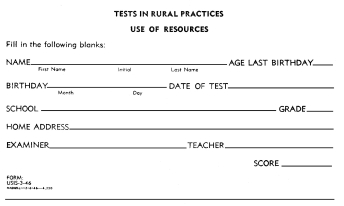
USE OF RESOURCES
Timber, form lands, coal, oil, mines and wild life are called natural resources.
Nature has given us these things to help us make a living.
DIRECTIONS: This test is made up of a number of items about some of these
resources. Each item has four possible answers. Choose the best answer
in each item and
place a check beside it Check only ONE answer in each item.
PART A
1. A person who understands the nature and importance
of natural resources, knows that
| _______A. |
the man who owns these resources should be allowed to use
them or sell them as he wishes. |
| _______B. |
all resources should be owned and controlled by the government. |
| _______C. |
the one who owns them should use them so that they will continue
to produce for many years to come. |
| _______D. |
the one who owns timber or other resources should sell all
of it whenever the price is high or the need is great. |
2. The money received from the sale of natural resources should be
_______A. divided equally among the owners.
_______B. used to build a large community building.
_______C. used to buy a herd of cattle to feed and sell on the market.
_______D. used to buy land or other resources of continuing value.
3. Irrigation is the method by which water is carried and applied to the soil.
Irrigation will
_______A. make sure of a good crop every year
_______B. provide water when it does not rain.
_______C. make it easier to farm the land.
_______D. help control weeds and insect pests.
4. Weeds rob the soil of plant food and cut down the yield of crops. The best
method to control harmful weeds on crop land is to
| _______A. |
pasture the fields with sheep, goats or cattle. |
| _______B. |
allow the fields to stand idle without cultivation every other year. |
| _______C. |
pull up all of the weeds that have gone to seed and burn hedges and
fence rows. |
| _______D. |
plant clean seed, cultivate thoroughly, and change crops from year
to year |
5. The greatest loss to farmers from insect pests results from the fact that
insects
_______A. make much extra work for the former.
_______B. annoy the livestock and keep them from feeding.
_______C. reduce the amount and quality of form and orchard crops.
_______D. cause the farmer to spend a great deal of money to control or destroy
them.
6. Insects which harm garden or fruit crops will best be held in check when
_______A. man leaves them to their natural enemies.
_______B. seeds are planted at greater depth.
_______C. sprayed or dusted with insect poison.
_______D. fields are cultivated regularly and frequently.
7. Less of the top soil of cultivated land will blow away during heavy winds
when
_______A. contour plowing is practiced.
_______B. every other strip of land is always covered with a growing crop.
_______C. whole fields are covered with the same type of crops.
_______D. crops are changed from year to year.
8. Clover and alfalfa should be included in farm crops because they
_______A. yield more feed than any other crop.
_______B. build up the soil more than any other crop.
_______C. always make a crop in dry years.
_______D. can be harvested when there is little other farm work.
9. Indians used to bury a fish in every hill of corn to
_______A. observe a religious practice of the tribe.
_______B. make the seed sprout more quickly.
_______C. get rid of spoiled fish.
_______D. fertilize the hill of corn.
10. Growing plants require food. They get this food from the soil in which
they grow. If crops are to be planted year after year on this land, food must
be returned to the soil. In your area this could be done by
_______A. spreading barnyard manure or commercial fertilizer on the fields.
_______B. allowing the land to lie idle every other year.
_______C. allowing no weeds to grow on the field.
_______D. burning straw and stubble on the ground after harvest.
11. Top soil will be prevented from washing away when
| _______A. |
a cover of protective growing plants is kept on the soil whenever
possible. |
| _______B. |
crops are planted in straight rows running from the top of the hill
to the bottom. |
| _______C. |
a prayer stick is planted in the middle of the field. |
| _______D. |
hillside fields are planted to cultivated crops year after year. |
12. A farmer or rancher would be wise to lease his form or grazing land only
when
| _______A. |
he has several small tracts of land widely separated and unprofitable
to operate. |
| _______B. |
it can be rented to a friend. |
| _______C. |
the owner needs an income. |
| _______D. |
the land cannot be used for crop farming. |
13. Native pasture grasses are destroyed when
_______A. the grass is cut for hay each year:
_______B. livestock keeps the gross cropped too close to permit
reseeding.
_______C. heavy winter snows cover the gross for long periods
of time.
_______D. rainfall in any one year is less than the average
amount.
14. A pure bred sire should be used in a livestock program
because
| _______A. |
all offspring could then be registered as full-bloods. |
| _______B. |
the off-spring will be hardier and better adapted
to the country. |
| _______C. |
the off-spring will be likely to have a higher market
value or produce more income. |
| _______D. |
that will guarantee 100 per cent yield of offspring. |
15. Every grain farmer should keep a flock of poultry because
it will
_______A. produce eggs and meat throughout the year
_______B. yield a very large income throughout the year
_______C. provide interesting and pleasant work for the younger
members of the family.
_______D. live on table scraps alone.
16. When the amount of annual rainfall is from 10 to 20 inches
conditions are usually well suited for
_______A. general farming and dairying.
_______B. stock raising and dry farming.
_______C. fruit growing and gardening.
_______D. no production of any kind.
17 Birds should be given shelter and protection in farming
areas because
_______A. they feed on weed seeds and insects that are harmful
to crops.
_______B. they can be killed to supply meat for the farmer.
_______C. they help carry seeds from place to place
_______D. they migrate to warmer countries in the winter
18 Sources of water supply give us drinking water, irrigation,
and power. These sources should be controlled by
_______A. the individual who owns the surrounding land.
_______B. a company of private businessmen organized for profit.
_______C. some agency of the government or community
_______D. the people who first discover it
19 Mineral and oil resources should be
| _______A. |
used up as rapidly as possible while the need is great
and the prices are high. |
| _______B. |
left in the ground so that the next generation may enjoy
their use. |
| _______C. |
taken from the ground only as long as large scale production
is profitable. |
| _______D. |
taken out of the ground under regulations that will prevent
waste and insure a supply for future needs. |
20 The main reason each state has game laws is to
_______A. provide an income for the state from license fees.
_______B. supply hunting for sportsmen.
_______C. prevent birds and wild animals from becoming scarce.
_______D. provide food for the Indians.
PART B
21. One of the best reasons why a person would want to be a
rancher or former is because
_______A. he enjoys the work and gets a living from his labor
_______B. he doesn't have a boss over him.
_______C. there is always good money in it.
_______D. all ranchers or farmers are successful men.
22. Planting a different crop each year is a good practice because
_______A. you can grow a larger variety of things.
_______B. it is less work.
_______C. it saves and returns plant food to the soil.
_______D. it brings a larger cash income each year.
23. If you were to examine different kinds of soil under a microscope, the
type which would appear to have the largest particles is
_______A. Sandy soil.
_______B. Looms.
_______C. Clay.
_______D. Humus.
24. When purchasing vegetable seeds, it is important to consider the
_______A. amount of seed received for the price.
_______B. reputation of the seed house.
_______C. size of the vegetables as shown on the package.
_______D. size of the seeds in the package.
25. For the purpose of control, harmful plant insects are classified as
_______A. large and small.
_______B. flying and crawling.
_______C. chewing and sucking.
_______D. hard and soft shell.
26. The tools which one would use in making a wooden box are
_______A. Hammer, plane, cold chisel.
_______B. Screw driver, brace, bit.
_______C. Hammer, square, saw.
_______D. Saw, nails, wrench.
27. To get the best information about farming and grazing, one should write
to the
_______A. governor.
_______B. state agricultural college.
_______C. United States Weather Bureau.
_______D. state department of education.
28. Before you use a farm Implement the first time, you should have someone
show you how to operate it because
_______A. it will save you time.
_______B. you can do a better job with less chance of damage to the implement.
_______C. directions are very seldom found on implements.
_______D. you would never be able to find out for yourself.
29. A farmer or a businessman can find out if he is making money or losing
money, if he
_______A. sells his products in the fall.
_______B. keeps complete records of the prices of what he buys and sells.
_______C. gets information from his friends.
_______D. asks the form agent.
30. Garden seed should be planted at such a time
that when the young plants appear, they will not be in danger from
_______A. heavy hailstorm.
_______B. severe drought.
_______C. early rainstorm.
_______D. late frost.
31. The age at which pigs should be weaned is
_______A. two to four weeks.
_______B. six to eight weeks.
_______C. three to four months.
_______D. six to eight months.
32. If a rope running through a pulley breaks, the best way to repair the break
would be to
_______A. tie the two broken ends together with a square knot.
_______B. buy a new rope.
_______C. splice the two ends together with along splice.
_______D. tie the ends together with baling wire.
33. Form machinery will lost longer if it is
_______A. used by neighbors and friends.
_______B. owned by several people.
_______C. left out in the rain and snow.
_______D. kept greased, repaired, and under shelter.
34. Lumber is generally bought by the
_______A. board foot.
_______B. square foot.
_______C. cubic foot.
_______D. square yard.
35. Grain is generally sold by the
_______A. bushel or hundred weight.
_______B. quart or gallon.
_______C. sack or wagon load.
_______D. cubic foot or square foot.
36. One of the best ways to have proof that you have purchased something is
to get a
_______A. bill of sale or receipt.
_______B. commission or discount.
_______C. money order or cash.
_______D. write your name on it.
37. If feed can be raised or is cheap, one or more hogs would be desirable
for family use in order to
_______A. provide cash when needed.
_______B. provide meat and lard.
_______C. keep snakes away from the house.
_______D. eat table scraps and garbage.
38. When training a horse to be ridden, one of the things a person should do
is to
_______A. whip him until he gives up.
_______B. hobble or tie his front legs.
_______C. treat him kindly but firmly.
_______D. keep feed and water from him until he obeys.
39. A few sheep on a small farm
_______A. will make the farmer a lot of money.
_______B. will furnish work for the children.
_______C. will eat many plants left by other livestock and
produce a regular Income.
_______D. will make nice pets.
40. To control lice on hogs it is best to
_______A. dip the hogs in a vat of disinfectant.
_______B. brush the hogs frequently with a stiff brush.
_______C. place an oiled sock on a post where the hogs can
rub against it.
_______D. see that hogs' rations contain plenty of minerals.
41. Pink eye is a common disease of
_______A. sheep.
_______B. hogs.
_______C. cattle.
_______D. chickens.
42. When judging beef cattle, the most important qualities
ore:
_______A. slow, quiet and easily handled.
_______B. low set, compact, and squarely built.
_______C. will pasture easily on open range.
_______D. gives a fair amount of milk for the family.
43. Pullets that grow slower than others in the flock should
be
_______A. kept for layers.
_______B. culled and eaten at home or sold.
_______C. trained for shows.
_______D. mixed with other breeds.
44. Potato beetles can be killed by
_______A. spraying or dusting the leaves of the plant with
poison.
_______B. spraying or dusting the beetles themselves with poison.
_______C. setting traps for them.
_______D. having a flock of crows in the potato field.
45. An animal dies from disease A good way to get rid of the
body would be to
| _______A. |
drag it to some low place and cover it with rocks. |
| _______B. |
sell it to one of the neighbors. |
| _______C. |
leave the body for the coyotes and birds. |
| _______D. |
dig a hole next to the animal, roll the body in and
cover it up with dirt and rocks. |
46. The age of a yearling horse or cow is about
_______A. 12 months.
_______B. 18 months.
_______C. 24 months.
_______D. 36 months.
47. The breed of beef cattle which has a white face is:
_______A. Shorthorn.
_______B. Angus.
_______C. Hereford.
_______D. Calloway.
48. Cattle are branded to
_______A. indicate their breed.
_______B. show what state they are from.
_______C. show who owns them.
_______D. provide training for boys.
49. Instruments should be disinfected before vaccinating each
animal in order to
_______A. practice what was learned in school.
_______B. abide by the law of the range.
_______C. prevent infection and the spread of disease.
_______D. keep the cattle from dying.
50. The future of the farming and ranching industry will generally
be good because.
_______A. more people are engaged in it than in any other industry.
_______B. there is an abundance of forming and grass land still
not in use.
_______C. many young men are being trained to become farmers
and ranchers.
_______D. people everywhere must depend upon the products of
farms and ranches.
51. The goat is a practical and useful animal for a family
because it
_______A. lives on rogs and trash around the house.
_______B. gives more milk than a dairy cow.
_______C. produces wholesome milk on a small amount of feed.
_______D. protects sheep.
52. Windows in a hen house should be placed so that
_______A. sunlight will strike every part of the floor sometime
during the day.
_______B. part of the floor will be dark at all times.
_______C. chickens will have fresh air blowing on them during
the day.
_______D. chickens can get out in case of fire.
53. A farmer insured his crop. It was later destroyed by hail.
When he tried to collect money for the damage, the company
told him that his policy did not protect the crop against hail.
The farmer should
_______A. sue the company for enough money to pay the damage.
_______B. buy insurance from another company.
_______C. form the habit of reading and understanding a paper
before he signs it.
_______D. write his Congressman, asking for a change in the
low.
54. In butchering animals it is important to bleed them freely
so that
_______A. the meat will cure properly and not spoil so easily.
_______B. the meat can be cut up more easily.
_______C. the meat will be more nourishing.
_______D. the animal will die quickly and the butchering can
be done faster.
55. For a vegetable garden, one should select a plot that is
_______A. protected from grasshoppers and stray horses.
_______B. fertile and near water.
_______C. level and near the house.
_______D. easy to cultivate.
56. Cattlemen with small herds should cooperate in shipping
cattle because it is
_______A. more fun to ship large numbers.
_______B. cheaper for each cattleman.
_______C. necessary to fill each stock car.
_______D. an opportunity for neighbors to work together.
57. Each rural family should have a garden because
_______A. the children can learn all about agriculture.
_______B. it will add to the looks of the farm.
_______C. the neighbors always have a garden.
_______D. it will supply the home with fresh vegetables.
58. In raising livestock it is very important to keep the barn
or pens clean and sanitary because
_______A. animals like to live in clean places.
_______B. barns and yards are made more attractive.
_______C. there are laws against dirt and filth.
_______D. this keeps the animals healthier.
59. The best way to learn forming and ranching while at school
is to
_______A. take part in agriculture projects.
_______B. learn by talking to other students.
_______C. make a written or oral report once a week.
_______D. listen to the teacher.
60. The best way to clean milk cans and buckets is to
_______A. scrub them with soap and water.
_______B. wash and put them in the sun to dry.
_______C. use a strong disinfectant on them.
_______D. wash in cold water, rinse in scalding water and put
in the sun to dry.
PART C
61. The money received from the sale of natural resources should
be
_______A. used to pay for the cost of a fair or rodeo.
_______B. used to buy land or other resources of continuing
value.
_______C. used to buy a herd of cattle to feed and sell.
_______D. used to build a large community building.
62. The purpose of irrigation is to
_______A. provide water for crops.
_______B. furnish water for homes.
_______C. make it easier to farm the land.
_______D. give work to more people.
63. Weeds cause greatest loss to agriculture by
_______A. providing food for prairie dogs.
_______B. providing a home for insects.
_______C. increasing erosion.
_______D. using food and moisture needed by planted crops.
64. Heavy winds will blow away less of the topsoil of cultivated
land if
_______A. a different crop is planted each year.
_______B. strips of tall growing crops are planted next to
row crops.
_______C. the some crop is planted all over the field.
_______D. there is lots of bare fond between rows of growing
plants.
65. Over a period of years, a herd of cattle can be improved
best by
_______A. feeding them alfalfa hay.
_______B. killing the slow-growing or stunted calves.
_______C. selling the calves while they are young.
_______D. using purebred bulls.
66. In an area where the soil is good but there is little rainfall
the conditions are usually suited for
_______A. general farming and dairying.
_______B. stock raising and dry farming.
_______C. fruit growing and gardening.
_______D. no production of any kind.

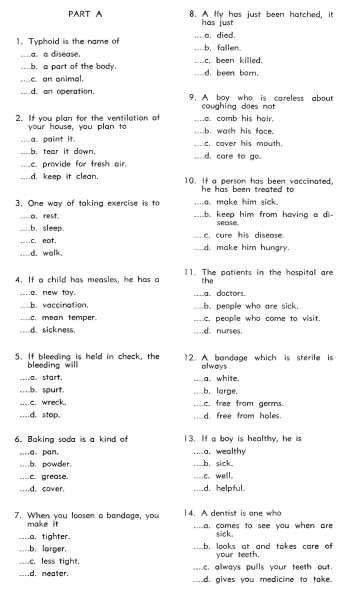





|